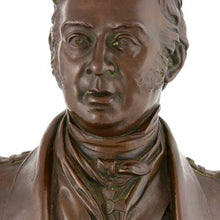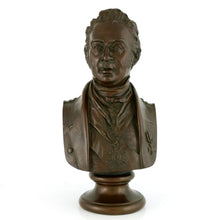Height: 25.5cm (10in)
Patinated bronze. Portrait bust in undress naval uniform of Charles Napier wearing the neck badge of a Knight Commander of the Bath, the Prussian Order of the Red Eagle, the Austrian Order of Maria Theresa, and the Russian Order of St George. Inscribed to the reverse ‘T. Thornycroft’.
Admiral Sir Charles John Napier KCB, RN (1786-1860) enjoyed a long and varied naval career, that included the capture of a French flagship; being twice wounded during the Napoleonic Wars; participation in a land battle with Wellington’s army in Portugal; being wounded in the War of 1812 and fighting a single ship duel. His later career included service in Portugal’s Liberal Wars and a victory over the fleet of the absolutist Dom Miguel in 1833. During the Syrian war of 1840 he led a combined force to victory in the land battle of Boharsef and setting in place the line of Egyptian succession that held until in 1952.
Read more
On the outbreak of the war with Russia in 1854, he received command of the Anglo-French fleet. However his force was chronically short of experienced seamen. Contradictory sets of orders from the Admiralty further hampered operations, but he nevertheless blockaded all the Russian ports, and sufficiently overawed the Russian Baltic Fleet so that it never left its moorings. He also carried out bombardment operations as far north as the Gulf of Finland, and tied down considerable Russian forces that otherwise might have been deployed in the Crimea, yet the Admiralty deemed his mission unsuccessful. In 1855 Napier was elected Member of Parliament, and continued his lifelong campaign against the Admiralty to improve the lot of the common seaman. He died in 1860 while hoping to persuade Garibaldi to acquire a fleet for the liberation of Italy, which he would command. Described as an ‘untidy man’ who walked with a limp and a stoop due to his leg and neck wounds. His nicknames in the Navy ranged from 'Black Charlie’, to ‘Mad Charlie', and even 'Dirty Charlie’ for his swarthy appearance; his eccentric behaviour and habit of wearing the most ill-fitting clothes while insisting that his officers were correctly dressed at all times.
Thomas Thornycroft (1815-1885) was born in Cheshire and was the pupil of the sculptor John Francis in London. In 1840 he married Francis' daughter, who was also a sculptor. In 1843 he entered the competition to find sculptors for the new Houses of Parliament, his exhibit winning him a commission to make two bronzes of barons as representations of the signatories to the Magna Carta of 1215. Thornycroft also enjoyed royal patronage, creating an over-life-sized plaster equestrian statue of Queen Victoria for the Great Exhibition of 1851. Fifty bronze casts based on this work were commissioned by the Art Union of London to be distributed as prizes between 1854 and 1859. In 1867 he was commissioned to make the marble group entitled Commerce for the Albert memorial in Kensington Gardens in London. Thornycroft also worked at intervals on a monumental representation of Boadicea and her Daughters aboard a two horse chariot with scythed wheels, which was finally cast in bronze in 1902 for installation on a plinth close to Big Ben on the Victoria Embankment, London. He exhibited regularly at the Royal Academy between 1839 and 1874. In later life Thornycroft worked with his elder son John Isaac Thornycroft (1843-1928, founder of Thornycroft shipbuilders) on designs for steam launches, a subject that would have been of considerable interest to Napier as an early innovator of steam powered naval vessels.






